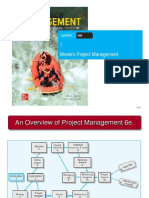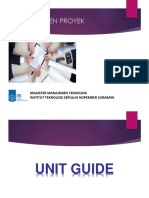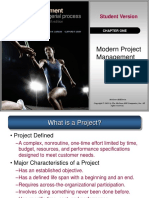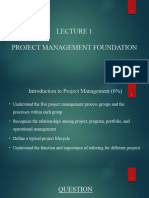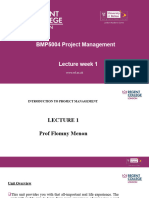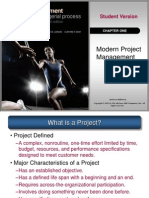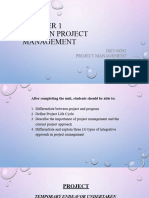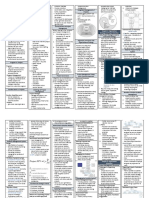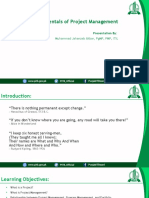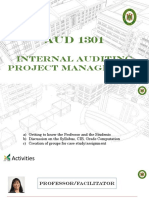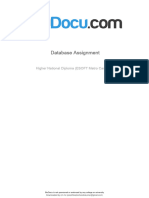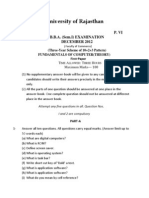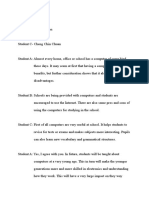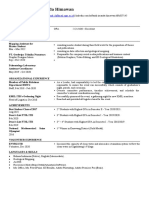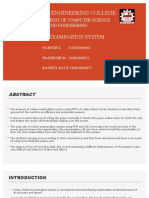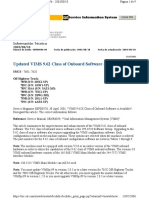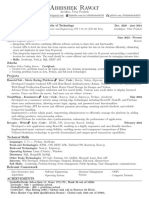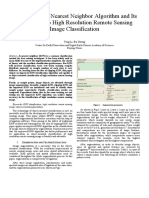2/19/2024
Definition of a Project
Introduction to Project “ A project is a temporary endeavor undertaken to create a unique product,
service, or result. ”
Management
Project Management
Project Management Institute (PMI)
“ A unique set of processes consisting of coordinated and controlled activities
with start and finish dates, undertaken to achieve an objective. ”
ISO 21500
1 2
What is a Project? Comparison of Routine Work with Projects
• Project Defined Routine, Repetitive Work Projects
Taking class notes Writing a term paper
–A complex, nonroutine, one-time effort limited by time,
Daily entering sales receipts into Setting up a sales kiosk for a
budget, resources, and performance specifications the accounting ledger professional accounting meeting
designed to meet customer needs.
Responding to a supply-chain Developing a supply-chain
• Major Characteristics of a Project request information system
–Has an established objective. Practicing scales on the piano Writing a new piano piece
–Has a defined life span with a beginning and an end. Routine manufacture of an Apple Designing an iPod that is
iPod approximately 2 X 4 inches,
–Requires across-the-organizational participation. interfaces with PC, and
stores 10,000 songs
–Involves doing something never been done before.
Attaching tags on a manufactured Wire-tag projects for GE and
–Has specific time, cost, and performance product Wal-Mart
requirements.
3 4
1
� 2/19/2024
Different Types of Projects
• Construction • Management
– Small or Large scale – Business improvement
building – Internal benefit
• Manufacturing • Scientific Research
– New product development – High risk, high return, often
– Process improvement unpredictable
• Computer Related Small, short projects
– Hardware Standard projects
– Software
Complex projects
5 6
Project Constraints
To exploit an opportunity
Why do – New technology
What will be
the budget of
What will be
the schedule
Projects To meet a need
the project? of the project?
Arise?
– Market demand
– Organizational demand
To solve a problem
– Customer request
– Legal requirement
What work will be done
and what will be the
result?
7 8
2
� 2/19/2024
The Challenge of Project Management
Project, Program, Portfolio
• The Project Manager Strategic
–Manages temporary, non-repetitive activities and - Are we working on
frequently acts independently of the formal Portfolio the right projects?
organization. (Doing the right thing)
• Marshals resources for the project.
• Is linked directly to the customer interface. Program
• Provides direction, coordination, and integration
to the project team.
• Is responsible for performance and success of the project.
Project Tactical
- Are the projects
carried out correctly?
(Doing things right)
9 10
Program versus Project
• Program Defined
–A series of coordinated, related, multiple Program • Program Defined
– A set of related projects
vs.
projects that continue over an extended – Continues for a long time
– Designed to reach towards a common
time and are intended to achieve a goal. goal
–A higher level group of projects targeted Project – All the projects within a program must be
completed in order for the program to be
at a common goal. complete
–Examples: • Example
• Projects: PROGRAM – Project: Completing a must course in
project management.
– adding a warehouse; setting up a production MANAGER – Program: Completing all the courses
line, building a bridge, construct a house necessary for an undergraduate diploma.
• Program:
– The Manhattan project, the Apollo project, the
Operation Desert Storm. & a public housing program
11 12
3
� 2/19/2024
• Portfolio Defined
Portfolio – A set of projects related in some way
• Relation may be strong or weak
• The results satisfy the stakeholders
vs. – All the projects within a portfolio are
treated as a single entity
– The higher allocation of the constraints to What is a
• On time
• Within budget
Project the portfolio reflects the importance of
the portfolio
Successful • At the desired performance level
• Not too much disturbance to the
• Example
PORTFOLIO
– Project: R&D for a metal-based lighter
material
Project? •
organizational workflow
Effective utilization of resources
– Portfolio (Strong connection): R&D
MANAGER projects of an organization
– Portfolio (Weak connection): All projects
of an organization
13 14
Definition of Project Increase in Project
Management Management
“ Project management is the application of knowledge, skills, tools, and
techniques to project activities to meet project requirements. ” • Business Trends
– Shortening of the product life cycle
Project Management Institute (PMI) – Global competition
“ Project management is the application of methods, tools, techniques and – Knowledge explosion
competencies to a project. ” – Corporate downsizing
ISO 21500 – Increased customer focus
It is not just scheduling!!! It is used to avoid project failures. – Small projects represent big problems
15 16
4
� 2/19/2024
Dimensions
of Project
Advantages of Project Management
Management • Project management
has two dimensions
• Improves overall project performance
• Improves quality • Technical:
corresponds to the
• Improves communication “science” of
• Reduces project time management
• Sociocultural:
• Reduces project risk corresponds to the
• Provides standard methodologies “art” of
management
• Provides accurate reporting and documentation
17 18
Project Life Cycle Stages of the Project Life Cycle
• Defining Stage
– Goals and objectives of the project are
established
– Specifications of the project are defined
– Teams are formed
– Tasks and responsibilities are assigned to
units
• Planning Stage
– Plans are developed to outline
• Schedule
• Budget
• Resources
• Risks
• etc.
19 20
5
� 2/19/2024
Stages of the Project Life Cycle Stages of the Project Life Cycle
cont’d cont’d
• Delivery Stage
• Execution Stage
– Product/Service is delivered to the
– Physical work of the project is customer
conducted
• Training customer and transferring
– Real-life data for the plans are collected documents
– Real-life data is used for control – Resources used for the project are
measures released
• Is the project on time? – New assignments for the teams
• Is the project within budget? members are found and members are
• Will the resources be sufficient? reassigned
– Any necessary changes/revisions are – Documentation
made • Project performance reviews
• Lessons learned
21 22
Integrated Management of Projects Alignment of Projects with
Organizational Strategy
• Problems resulting from the uncoordinated
project management systems include:
– Projects that do not support the organization’s
overall strategic plan and goals.
– Independent managerial decisions that create
internal imbalances, conflicts and confusion resulting
in dissatisfied customers.
– Failure to prioritize projects results in the waste of
resources on non-value-added activities/projects.
23 24
6
� 2/19/2024
Major Functions of Portfolio
Management: The “Science” and “Art” of Project
Management
• Oversee project selection.
• Monitor aggregate resource levels and skills.
• Encourage use of best practices.
• Balance projects in the portfolio in order to represent a risk
level appropriate to the organization.
• Improve communication among all stakeholders.
• Create a total organization perspective that goes beyond silo
thinking.
• Improve overall management of projects over time.
25






